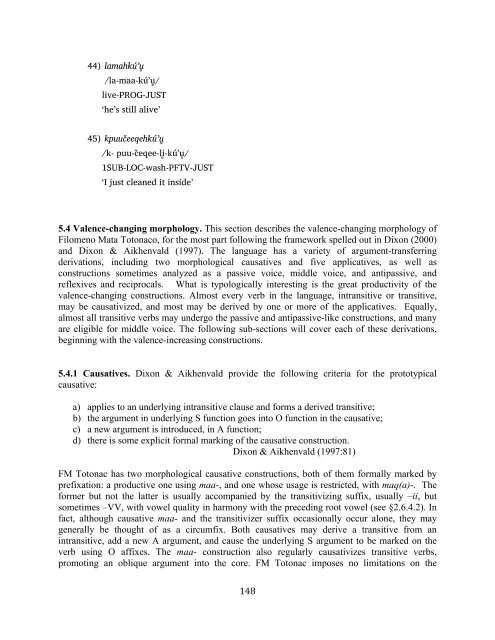The phonology and morphology of Filomeno Mata Totonac
The phonology and morphology of Filomeno Mata Totonac
The phonology and morphology of Filomeno Mata Totonac
Create successful ePaper yourself
Turn your PDF publications into a flip-book with our unique Google optimized e-Paper software.
44) lamahkú*u&<br />
/la-maa-kú'u&/<br />
live-PROG-JUST<br />
‘he’s still alive’<br />
45) kpuuc%eeqehkú*u&<br />
/k- puu-c"eqee-li&-kú'u&/<br />
1SUB-LOC-wash-PFTV-JUST<br />
‘I just cleaned it inside’<br />
5.4 Valence-changing <strong>morphology</strong>. This section describes the valence-changing <strong>morphology</strong> <strong>of</strong><br />
<strong>Filomeno</strong> <strong>Mata</strong> <strong>Totonac</strong>o, for the most part following the framework spelled out in Dixon (2000)<br />
<strong>and</strong> Dixon & Aikhenvald (1997). <strong>The</strong> language has a variety <strong>of</strong> argument-transferring<br />
derivations, including two morphological causatives <strong>and</strong> five applicatives, as well as<br />
constructions sometimes analyzed as a passive voice, middle voice, <strong>and</strong> antipassive, <strong>and</strong><br />
reflexives <strong>and</strong> reciprocals. What is typologically interesting is the great productivity <strong>of</strong> the<br />
valence-changing constructions. Almost every verb in the language, intransitive or transitive,<br />
may be causativized, <strong>and</strong> most may be derived by one or more <strong>of</strong> the applicatives. Equally,<br />
almost all transitive verbs may undergo the passive <strong>and</strong> antipassive-like constructions, <strong>and</strong> many<br />
are eligible for middle voice. <strong>The</strong> following sub-sections will cover each <strong>of</strong> these derivations,<br />
beginning with the valence-increasing constructions.<br />
5.4.1 Causatives. Dixon & Aikhenvald provide the following criteria for the prototypical<br />
causative:<br />
a) applies to an underlying intransitive clause <strong>and</strong> forms a derived transitive;<br />
b) the argument in underlying S function goes into O function in the causative;<br />
c) a new argument is introduced, in A function;<br />
d) there is some explicit formal marking <strong>of</strong> the causative construction.<br />
Dixon & Aikhenvald (1997:81)<br />
FM <strong>Totonac</strong> has two morphological causative constructions, both <strong>of</strong> them formally marked by<br />
prefixation: a productive one using maa-, <strong>and</strong> one whose usage is restricted, with maq(a)-. <strong>The</strong><br />
former but not the latter is usually accompanied by the transitivizing suffix, usually –ii, but<br />
sometimes –VV, with vowel quality in harmony with the preceding root vowel (see §2.6.4.2). In<br />
fact, although causative maa- <strong>and</strong> the transitivizer suffix occasionally occur alone, they may<br />
generally be thought <strong>of</strong> as a circumfix. Both causatives may derive a transitive from an<br />
intransitive, add a new A argument, <strong>and</strong> cause the underlying S argument to be marked on the<br />
verb using O affixes. <strong>The</strong> maa- construction also regularly causativizes transitive verbs,<br />
promoting an oblique argument into the core. FM <strong>Totonac</strong> imposes no limitations on the<br />
! "(,!

















